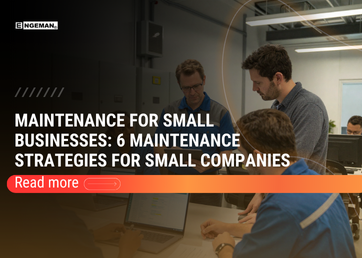Contents
Total Productive Maintenance (TPM) are important practices that lead to a reduction of errors and failures in the maintenance sector. All stages of TPM aim at working in a process that involve all company professionals to achieve superior quality products and zero breaks and failures.
Adopting TPM, as we saw in the first articles of this series, requires a change in behavior of everyone in the company, so everyone will follow the same vision and the results in the processes will be visible, both in increasing the useful life of the equipment and in the quality of the products of the production line.
In the first articles of this series, we have talked about the first steps of the implementation of TPM and the importance of each process. It is important to note that each pillar addresses specific actions as we talked about in the last article, Quality Maintenance, which values the quality of the products that are offered by organizations.
In this article we will address the fourth pillar of TPM which is the pillar of Specific Improvements. Keep reading and learn all about this pillar and its importance to increase your company’s productivity.
Definition of the Pillar of Specific Improvements
The Specific Improvements pillar refers to activities that are developed to enhance the overall efficiency of an equipment and reduce/eliminate losses and waste in organizations. Through this pillar it is possible to identify all the losses and waste that are happening and act to reduce and eliminate them, thus increasing the productive potential of the company.
In Specific Improvement, the purpose is to improve individual equipment to eliminate the six major losses that have a direct influence on OEE – Overall Equipment Efficiency. These six major losses are:
- Breakdown:which concerns the breakdown of equipment and can be very expensive for the company;
- Setup:it is related to the adjustments that need to be made to the machines so that they can work normally;
- Idle time: it is the time that the machine needs to stop for some adjustment, which interferes with production causing delays;
- Low speed:which happens when the equipment operates at a lower speed causing the pace of production to be impaired;
- Defects in the process and rework: it happens when there is a problem in the process, be it due to lack of experience of the professionals, incorrect settings, among others. These defects can generate lower quality products.
- Start-up:it is a problem often related to suppliers since some defects happen before the production process still with inputs or raw material.
By eliminating losses, there is an improvement in equipment efficiency, as well as availability, quality and performance.
Steps for specific improvements
To implementat any of the steps of the TPM, it is necessary to plan ahead. It is important to delimit the problems and objectives to be achieved, train staff and invest in this methodology. The TPM steps are applied simultaneously to other steps so that the objectives can be achieved.
Indicators such as availability, OEE, criticality are just a few examples that should be used to plan an action properly.
The steps for implementating of the Specific Improvements pillar can be carried out as follows:
- Gather all professionals who have some connection in the production process to form a continuous improvement team (KAIZEN)that can detect the problems of the production process;
- Organize a flowchart of the entire production process, covering from the arrival of the material to the shipment of the product;
- Make a survey of all the losses that happen in the production chain. Identify the failures, the defects, look for bottlenecks in the processes. Use the indicators so that you can outline the goals of your project;
- With all losses mapped, identify problems and abnormalities;
- Through the 5 whys diagram, check and analyze the causes of these problems and losses;
- Apply the 5W2H action plan to define the actions that will be effective and make monitoring more agile and simplified;
- Implement the actions that have been outlined and follow up to verify the effectiveness of the actions;
- After that, you will already be able to correct the errors that were identified and replicate the actions in similar events;
- Verify and disseminate the results to the various levels of the company so that actions can be replicated. Note if the objectives outlined are generating the expected results and, if not, start over by point 3.
The team that is part of this pillar of Specific Improvements needs to be multidisciplinary, that is, they need to have different knowledge and skills so that each one can show their point of view in solving problems.
Benefits
Specific Improvements is a very important pillar in eliminating the chronic problems of the production process. It helps increase OEE and has an influence on the maintainability of company assets. Thus, there is a considerable improvement in the Planned Maintenance and Autonomous Maintenance pillars. This pillar always prioritizes OEE and asset criticality, among other indicators.
With the resolution of problems, the company will gain more reliability, cost reduction and increased productivity.
Conclusion
All the problems that happen in a company and that interfere in the production process interfere with the reliability of organizations. Being attentive to everything and involving all employees at all stages are practices that can transform the productivity of companies. Analyzing problems in meeting rooms is often not an effective practice because they must be analyzed in the place where they happen, which is in the field.
The Specific Improvements Pillar involves professionals from many areas within the company in order to correct equipment failures following the maintenance indicators and thus the company gains in productivity, competitiveness and efficiency.
In this pillar, it is defined which improvement should be achieved and through methodology and activities such as Kaizen, the multidisciplinary team can act more focused on the company’s problems.
So, how are you enjoying our series of TPM pillars? In the next article we will talk about the Early Management and how this pillar can be effective for the company’s future actions. Don’t miss out, follow Engeman social media page and always be well informed.We’re on Facebook, Instagram and Telegram!



